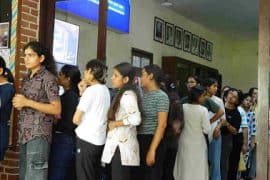World War 2 or the Second World War was the last major global conflict wherein the dominant powers from all over the globe fought. The war cost humanity over 75 million lives and unimaginable damage to flora as well as fauna. USA, UK, Soviet Union, India, Italy, Nazi Germany, Imperial Japan, China and many other nations were part of this bloodshed. And yes, you heard it right, India.
Image Credits: Bettmann
Image Caption: Indian troops with a Nazi flag, the Reichskriegsflagge (Imperial War Flag) in the rubble of Western Desert trenches, Libya, in May 1942 after the capture of Omar Al Mukhtar, the resistance leader against the Italian occupation. Up to 2.5 million Indians fought for Britain during the Second World War.
No, in this article you will not hear anything about the Indian National Army but instead, you will hear about the British Indian Army. The soldiers who participated in a war that wasn’t theirs and still they won it for their sahibs. However, as all the world praised their ‘boys coming home’, these heroes were humiliated and even abandoned, as they had fought for the ruthless rulers of India, the British. You must have seen numerous war movies that depict the heroic acts done by the soldiers on the battlefield. However, the Indian soldier never got this limelight and instead was portrayed as a traitor.
The British being British, at the starting of the war, stated that they didn’t need any Indians or other Commonwealth forces to take part. But to their dismay, by the end of the war in 1945, India had contributed more than 2.5 million soldiers and 14 million factory workers when Britain itself contributed just 3.7 million workers. Around 87,000 men died in this war and to sum up India’s participation in the war, the Commander-in-Chief of the Indian Army, Field Marshall Sir Claude Auchinleck said, “The crown couldn’t have come through both wars (World War 1 and 2) if they hadn’t had the Indian Army.”
Image Credits: Imperial War Museum Archives
Image Caption: Indian infantrymen of the 7th Rajput Regiment about to go on patrol on the Arakan front in Burma, 1944.
The Indian presence in the British forces started ramping up after the 1940s. This presence started growing rapidly after the fall of France which was marked by the Dunkirk evacuations on the west and after the fall of Singapore in the east. Interestingly, though not shown in Nolan’s war epic, Dunkirk, nearly four companies of the Royal Indian Service Corps were present during the evacuations. The British needed Indian soldiers to defend the British Isles. In BBC’s words, “The Empire did not have enough men and resources to protect itself after the fall of France to the Nazis.”
THE WAR
Image Credits: Imperial War Museum Archives
Image Caption: Humber armoured cars of 10th Indian Division move forward in Italy, 22 July 1944.
The Indians saw action from Burma (now Myanmar), East Asia and Southeast Asia in the east while they fought in North Africa, Italy, Middle East, France and Germany in the West. India itself was invaded by the Japanese along with Bose’s Indian National Army. This led to the fierce battles of Kohima and Imphal where for the first time the Japanese faced a major defeat on land since the start of the war.
India rose as a robust industrial power during the war. By 1945, India had emerged as the 4th largest industrial power after USA, UK and the Soviet Union itself. The Great Bengal Famine of 1943 was also a result of India’s participation in the war. As Winston Churchill had denied the release of emergency rations owing to war needs and this resulted in the death of around 3 million Indians, even more than the whole Indian army. India is even the inventor of the Bangalore Torpedo, an obstacle-clearing explosive tube. Which was used extensively by the Allied during the war and has been regularly featured in popular media like the video game Call of Duty: World War 2 and movies like saving Private Ryan.
Image Credits : British Air Ministry Second World War Official Collection
Image Caption :Arjan Singh (Center) (Later India’s first and only Marshal of the Indian Air Force ) as the Flight Lieutenant with Indian pilots of No.1 Squadron by a Hawker Hurricane at the Burma Theatre.
The Royal Indian Air Force along with the Royal Indian Navy were smaller components of the British Indian Armed forces but still contributed around 1,03,000 soldiers. Indian pilots took part in great air battles like the Battle of Britain and fought the Japanese air force in the Southeast Asian theater. Our pilots and sailors won many honours including two Distinguished Service Order, the second-highest military award of the British Empire Commonwealth.
Image Caption: The three highest military decorations of the British Empire the Victoria Cross, the George Cross and the Distinguished Service Order (From left to right)
The British Indian Army, being the largest component of the Indian armed forces contributed the most. The army was part of every theatre in the war barring the Pacific Theatre. Be it the invasion of Southern Italy, gruesome battles of North Africa or unforgiving jungles of Burma, the Indian soldier stood strong in every battlefield.
Image Caption : An Indian soldier in the uniform of ‘Legion Freies Indien‘ or the Free Indian Legion which was a part of the Nazi Germany Wehrmacht Heer (The Nazi German Army). On the right pocket we can see the Infantry Assault Badge (Left) and Wound Badge (Right) awarded to the soldier.
The Indians were among the few, if not the only ones, who fought for the Allied as well as the Axis. In addition to INA (Indian National Army) aiding Japan, Indians were also a part of the German and Italian armies. These soldiers were PoWs (Prisoners of War) of the Axis who were organised into a fighting force by SC Bose himself, before he left for Japan in 1942. These forces were part of the D-Day defences mounted by the Nazis as well as the Retreat from France. In total the Indian army won 31 Victoria Crosses and 7 George Crosses, the highest British military honours for combat and non-combat roles, respectively. For perspective, the cross was only awarded 182 times in the whole World War 2. The war also cost India over 1,35,000 civilian deaths caused due to Japanese bombings on the city of Kolkata due to the metropolis being a major supply hub to the allied forces in the Pacific and East Asia. The city was so important to the British that it reportedly had one of the ‘best air defence systems’ in the eastern world. In comparison, nearly 40,000 people had died in the German bombings in London.
THE DENIAL
Image Credits: Bridgeman
Image Caption: Indian souldiers share a cigarette while on a break from the battlefield. (Source: Bridgeman)
It has been hotly argued since 1947 if we should be highlighting the role of Indians in the war when they were fighting for their oppressors. Thus, these soldiers are denied even a memorial commemorating their sacrifice. Consequently, the National War Memorial has names of martyrs from 1947 onwards and the India Gate has the names of the fallen of the First World War only. Many people including famous columnist and Amnesty International India’s head, Aakar Patel, even equated the erstwhile British Indian army to ‘just a mercenary force’ and disregarded the very force which won accolades of not only its allies but also of its foes.
A mercenary force fights just for money but in reality, the pay as well as the amenities of Indian soldiers, were negligible as compared to their British counterparts. We need to celebrate the Indian army’s contribution to the war not because of its loyalties but because of its bravery and professionalism. Even the Europeans themselves have forgotten the Indian contribution to the war and so have Indians. So much so that when Indian soldiers were shown in the war epic, 1917, the British actor Laurence Fox termed them as being ‘not suitable to the environment’ and ‘a forced diversity’. This mere statement is a testament of the European ignorance against their colonies which even our countrymen are now aiding.
Image Caption: The British newspaper, Daily Mail, reports the Japanese invasion in India during the first week of March, 1944
We need to celebrate the force that got British the news of their first triumph in the whole war against the Axis from Africa fighting the Italians and the Nazis. And the first land victory against Imperial Japan in South East Asia when the Japanese soldier was thought to be invincible. We ought to salute the force which stopped the Japanese from overrunning India and thus saving India from their ruthless rule. We ought to bow to the soldier who fought valiantly in Monte Cassino and saved this world from a merciless rule of the Nazis. At last if one may find themselves incapable of any of this, then at least give the same respect to these soldiers and people as is given to an American or a British one.
Feature Image Caption: Indian soldiers in the Mediterranean region in position with a Vickers-Berthier Light Machine Gun
Aniket Singh Chauhan











Comments are closed.